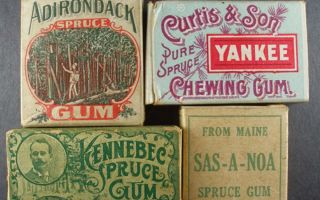Content
Gum is a common product and is loved and used by people of all ages. It seems to be a technological innovation. In fact, chewing gum has an interesting, centuries-old history.
The history of chewing gum
People have long used the gifts of nature for various purposes, knowing their useful and harmful properties. Minerals and insects were used. For oral hygiene, plant roots were helpful.
An ancient chewing gum was used by the Maya Indians, it was a substance made from rubber juice - chicle. There is evidence that in northern Europe, people used birch resin to relieve toothaches. The Aztecs had codes of conduct associated with this remedy. Unmarried women and children were allowed to chew whenever they wanted, married women and widows were allowed at home, and men were instructed to hide.
People have known about the product since antiquity. The people of North America adopted this useful experience from the Indians.
At this time, the Curtis brothers came up with the idea of mixing pine resin with beeswax and selling this invention. The gum was a good success. This allowed an increase in production volumes in 1850. Then paraffin flavors were added to the composition, 4 brands of chewing gums were produced.
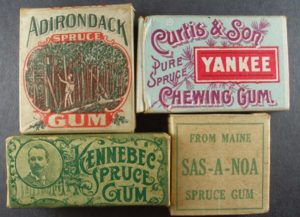
In 1869 dentist William Semple patented rubber chewing gum. It includes: charcoal, chalk, flavorings. He assured that chewing gum has properties useful for teeth and is durable. Due to unclear circumstances, the product did not go to mass production.
According to legend, in 1869 a general who fled from Mexico meets the inventor Thomas Adams and sells chicle (rubber). He failed to create a substitute for rubber. Then the inventor welded rubber and made chewing gum, which was quickly sold out in local shops.
Then he introduced licorice flavor. The Black Jack was born - the first flavored gum. In 1871, Adams received a patent for an apparatus for mass production of a product. In 1888, the Tutti Frutti gum appeared. Pharmacist John Colgan suggested adding flavor to the mixture before adding sugar. The smell and taste now stayed longer.
Salesman William Wrigley noticed that the gum was in demand and decided to improve the manufacturing method. In 1892, Wrigley's Spearmint was produced, a year later - Wrigley's Juicy Fruit. These types of chewing gum hold the first lines of world sales today. Wrigley came up with the idea to add mint, powdered sugar and other flavors, to produce gum in different shapes.
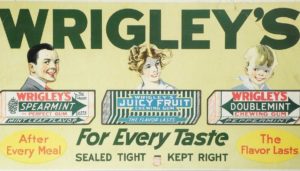
The researcher improved the product of Frank Fleer, which was not in demand. Children liked chewing gum very much as entertainment. Competitions were held among her amateurs.In 1994, they set a world record: a 30.8 cm bubble was inflated. Then they did not think about the benefits, properties or harm of chewing gum.
After 1945, thanks to the soldiers, the whole world learned about it. In the USSR, there were only Soviet counterparts that did not have pleasant properties, in an ugly package. In the 1990s, candy wrappers from foreign gum were collected and used for games.
Chewing gum composition
Chewing gum contains:
- base: rubber or other synthetic polymers - 20-30%;
- food sugar or sweeteners - 60%;
- flavor enhancers;
- stabilizers (usually glycerin);
- aroma enhancers;
- emulsifiers (based on egg yolk);
- dyes;
- thickener E414;
- lemon acid;
- titanium dioxide (provides a snow-white color);
- preservative (antioxidant).
It has changed a lot from the ancient gum. These are the main components. The content of these substances in popular types of gum:
Is chewing gum good for you?
You might think that its properties are extremely harmful. The media actively promotes the positive effect of chewing gum on teeth.
Active salivation
Microbial colonies are formed on the teeth within 2 hours after brushing. They recycle food debris, forming acids that destroy enamel. The result is caries. During chewing, saliva is reflexively released, which has a slightly alkaline ph and contains mineral components. The properties of chewing gum really strengthen the tooth enamel, neutralize the environment, but not at the expense of their composition.
Intestinal motility and secretion are reflexively activated. A person recovers faster after bowel surgery and switches to daily food thanks to chewing gum.
Cleansing the mouth and teeth
The teeth have a pronounced anatomy - deep pits, can be crowded. Then food and plaque are clogged there. But according to dentists, there are benefits of the properties of gum after eating.
Strengthening the jaws
You can use chewing gum as an unusual exercise machine. This is a useful property. When chewing, the load on the teeth and their ligaments falls, then on the jawbone and muscles. This beneficial property helps develop the maxillofacial skeleton in children.

Helps to calm down
The gum tastes good and has a cooling effect. It does not lose consistency, volume, does not dissolve, not only freshens breath, but helps to calm down, the effect of the action itself has been scientifically proven. Chewing gum has many health benefits. But there is also harm from it.
Why is chewing gum harmful?
A useful product can be harmful, not to mention chewing gum.
The emergence of addiction
People deal with stress in different ways. Someone smokes, eats, someone uses chewing gum. There are studies confirming the emergence of dependence on it.
Breakage of dentures and loss of fillings
Studies have shown that there have been cases of unpleasant effects from chewing gum, but they are rare. If you have all your teeth, the filling is made correctly, from high-quality material, then it (or the prosthesis) will last a long time. But they can absorb colorants and flavors from gum, which reduces the service life of the structure. An elastic band is not recommended for people with braces or teeth straightening plates. When chewing, structural elements may bend, the briquette may come off or the product will stick to them, which will impair oral hygiene. This will harm, complicate treatment.
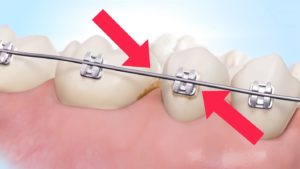
Poisoning effect
To determine the presence of this property in chewing gum, you need to study the composition in detail. The basis is synthetic polymers. No effect on the body has been identified.
Glycerin (E422) draws water from tissues. There is little of it in chewing gum, but it is used in the composition of frequently used products: bread, confectionery.
Sugar does not cause tooth decay, but it is a breeding ground for bacteria. Some people use a sweetener called sorbitol. This substance is a laxative. Aspartame can cause headaches and allergies. Xylitol and maltitol in gum are relatively safe to consume.
Flavors, both natural and synthetic, can cause allergies. Long-term chewing flavor enhancers harm the taste buds. Common wholesome foods seem unpleasant with prolonged use of the gum.
The dyes contained in the gum are carcinogenic. Carcinogenicity - the ability to cause cellular mutations. So far, there is not a single case of cancer or other neoplasm due to gum.
Gum harm to children
Children are very curious, they can give each other food to try. There is a risk of passing the infection from one child to another through saliva. He can become infected himself if he leaves a gum somewhere or drops it, and then chews.

Do not give gum to a child instead of food. This is harm. Saliva and gastric juice containing hydrochloric acid are reflexively secreted. Since food does not enter the stomach, the acid will act on its lining, causing gastritis. This disease leads to problems with digestion and absorption of beneficial nutrients from food, which is especially bad for a growing child's body.
Asymmetry of the face
With frequent and prolonged chewing, especially on one side, muscle overload and overdevelopment occur, which is negative for the growth of the jaws. They may be underdeveloped or overdeveloped. One half can be longer or longer than the other. These are pronounced effects from excessive and prolonged use of gum, which are harmful.
Hence the problems with the bite: crowding, improper closing of teeth, maxillofacial pathologies, especially in combination with bad habits (gnawing a pen, pencil, nails). Their signs and consequences: problems with the temporomandibular joint (TMJ), changes in the profile and configuration of the face, even problems with posture. But there are benefits of chewing gum for humans, it is not just an advertisement.
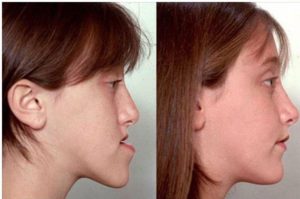
How to chew gum safely
It is not a substitute for brushing and brushing. You can use chewing gum after eating for no more than 10 minutes. Rinse your mouth out beforehand to avoid harm to your teeth. The properties of chewing gum after eating can be used for weight loss, as it stimulates the secretion of gastric juice, and food is better absorbed. There is an elastic band designed specifically for weight loss.
You cannot replace a full meal with chewing gum. It will be harmful. There are alternative chewing gum replacement options that are more beneficial.
What can replace chewing gum
You can use mints, pills, mouth sprays, and hygienic rinses. The question of their properties and harm to the child is decided after consultation with the doctor. For a healthy snack, yogurt, dried fruits, fresh fruits are suitable. For the development of the child's chewing apparatus, solid foods will be useful: carrots, apples.
Culture and chewing gum
In the 1990s, chewing everywhere and everywhere was fashionable in Russia. But no one will like the interlocutor doing this during a conversation or in the theater. This is uncivilized. An active life forces you to snack on the go, but everything should be in place, you can not abuse chewing gum.
How to make chewing gum at home
Children love gum very much. To avoid harm, you can learn how to cook a healthy product at home.
Recipe for chewing gum useful for children of all ages:
- choose juice as desired, add sugar and heat;
- add to gelatin, mix and strain through a sieve;
- pour the mixture into molds and leave in the refrigerator for 6-8 hours.

The gummy is ready. She will remind marmalade, have both a pleasant taste and useful properties.
Making fruit or berry chewing gum:
- peel products, cut;
- pour boiling water over, cook for 20 minutes over low heat;
- when everything is boiled down, drain the compote, add sugar and gelatin (dissolved in water);
- you can use molds or put the gum in a container for solidification;
- put in the refrigerator for several hours.
The healthy chewing gum is ready. You can take it with you for a snack.
Recipe for a treat for older children. Gum base chewing gum, which is purchased in the store and over the Internet.
- 1 tbsp. l. Warm up gum bases in a water bath, stirring occasionally;
- pour in liquid honey or syrup - 1 tsp;
- mix;
- add 1 tsp into the mixture. flavoring, 1/2 tsp. tablespoons of powdered sugar, dye (optional);
- sprinkle the table or cutting board with powdered sugar;
- lay out the hot gum;
- during cooling and after you need to roll it in powder;
- form a sausage, cut into pieces.
The taste and properties of the finished gum will be similar to the purchased one. With the addition of dyes and flavors, they will be distinguished only by the absence of a bright wrapper.
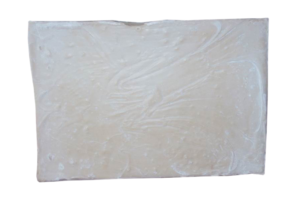
Conclusion
The benefits and harms of chewing gum is a complex issue, but if you follow simple rules, its use will be beneficial. She masks problems. First of all, proper care with the properties of chewing gum for the oral cavity will help maintain the beauty of a smile and health for many years.


